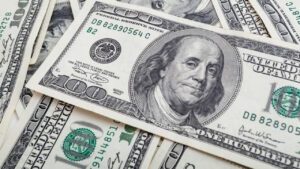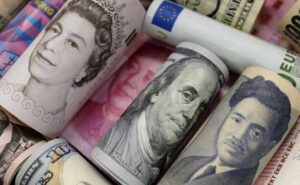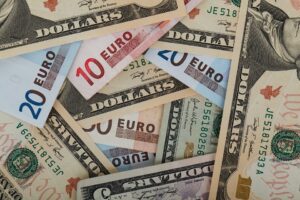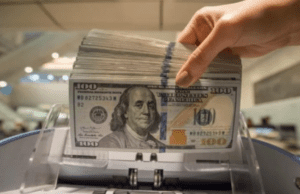
The US dollar is getting cheaper against the euro and the pound sterling during the trading session on Tuesday.
The day before, the U.S. currency steadily strengthened on statements by Federal Reserve (Fed) officials that dampened investor optimism that the rate hike cycle may end soon.
Fed Vice Chair Lale Brainard told Bloomberg on Monday that the Fed is likely to slow the pace of rate hikes soon.
“However, I think it’s important to emphasize: we’ve done a lot already, but we still have more work to do,” Brainard said.
Earlier Monday, her colleague Christopher Waller, a member of the Fed’s board of governors, warned investors against overly optimistic about the timing of the end of the policy tightening cycle, noting that the Fed still has much work to do.
“We have a long, very long way to go to slow inflation. The rate will continue to rise, and it will stay high for a while, until we see it get closer to our target level,” Waller said at an event in Sydney hosted by UBS.
The ICE-calculated index, which shows the dollar’s performance against six currencies (euro, Swiss franc, yen, Canadian dollar, pound sterling and Swedish krona), added 0.2% on Tuesday, while the broader WSJ Dollar lost 0.03%.
The euro/dollar pair is trading at $1.0333 as of 9:15 a.m. Ksk, compared to $1.0329 at the close of the previous session. The pound rose to $1.1776, compared to $1.1760 the day before.
The dollar rose to 140.31 yen against 139.88 yen at the close of previous trading.
The exchange rate of the U.S. currency paired with the yuan dropped to 7.0491 yuan against 7.0740 yuan the day before. On Tuesday, the People’s Bank of China (PBOC, the country’s central bank) injected 850 billion yuan ($120.7 billion) into the financial system as part of its medium-term lending program (MLF).

The dollar is weakening against the euro and is recovering against the yen after a sharp drop against almost all world currencies the day before, triggered by data on a significant weakening of inflation in the United States.
As it became known on Thursday, consumer prices (CPI) in the United States rose by 7.7% in October against the same month last year after an increase of 8.2% in September. Thus, inflation slowed to its lowest since January and was well below market forecasts.
The data may affect the policy of the U.S. Federal Reserve (Fed), which is aggressively raising interest rates in an attempt to curb inflation.
The head of the Federal Reserve Bank (FRB) of Philadelphia, Patrick Harker, already spoke in favor of slowing further rate hikes.
“In the coming months, in light of the cumulative tightening (of QE – IF) already achieved, I expect the pace of rate hikes to slow down as we get closer to sufficiently restrictive policy,” Harker said during a speech at an event in Philadelphia.
The ICE-calculated index, which shows the U.S. dollar’s performance against six currencies (euro, Swiss franc, yen, Canadian dollar, pound sterling and Swedish krona), is down 0.25 percent. The day before, the indicator was down 2%.
The euro/dollar pair is trading at $1.0218 by 7:55 a.m. Ksk, versus $1.0209 at the close of Thursday’s session, with the euro strengthening 0.1%.
The dollar/yen is up 0.4% at 141.57 yen, up from 140.97 yen at the end of last session.
The pound is changing little and is trading at $1.1716 compared to $1.1715 at the close of previous trading.
The mainland yuan rose 1.1 percent to 7.1089 yuan per $1, renewing a four-week high.
The Australian dollar is up 0.5 percent at a seven-week high of $0.67, despite statements by Australia’s Deputy Central Bank Governor Michelle Bullock that the country’s interest rate is likely to continue rising.

Traders are waiting for inflation data in the U.S. for October, which will be released by the U.S. Labor Department on Thursday at 15:30.
Experts polled by Trading Economics forecast on average a slowdown in consumer price growth in the country to 8% year on year from 8.2% in September.
The U.S. inflation report for October is likely to be a key factor in determining how much the Federal Reserve (Fed) will raise rates at its December meeting.
The market is currently pricing in a 50 basis point (bps) rate hike in December, but a higher-than-expected October inflation rate could shift those expectations in favor of another 75 bps increase, Trading Economics notes.
The ICE-calculated index showing the dynamics of the dollar against six currencies (euro, Swiss franc, yen, Canadian dollar, pound sterling and Swedish krona) is adding 0.28%, while the broader WSJ Dollar is adding 0.33%.
The euro/dollar pair is trading at $0.9950 as of 3:30 p.m. MSC, compared to $1.0014 at market close on Wednesday.
The European Central Bank (ECB) on Thursday took steps to address a shortage of highly liquid government bonds on the market, which are used as collateral in market transactions. The problem has become urgent as the ECB has been buying bonds for years in a row as part of its quantitative easing program.
On Thursday, the ECB decided to increase to 250 billion euros from 150 billion euros the limit for securities lending to financial institutions against cash collateral, said Isabel Schnabel, a member of the ECB’s executive board.
“This is a precautionary measure to alleviate the shortage of securities collateral in the market and keep it functioning at the end of the year,” she wrote on Twitter.
The U.S. currency is at 146.47 yen versus 146.41 yen in the previous session. The pound rose to $1.1392 from $1.1357 the day before.
The dollar/yuan pair is trading at 7.2535 yuan against 7.2419 yuan at the close of the previous session.

The U.S. dollar is strengthening against the euro, yen and pound sterling in trading Tuesday.
The ICE-calculated index showing the dollar’s dynamics against six currencies (euro, Swiss franc, yen, Canadian dollar, pound sterling and Swedish krona) is adding 0.22%, while the broader WSJ Dollar is up 0.14%.
The euro/dollar pair is trading at $1.0007 as of 8:15 a.m., compared with $1.0022 at Monday’s market close.
The U.S. currency rose to 146.67 yen from 146.61 yen in the previous session.
The pound exchange rate fell to $1.1491 from $1.1514 the day before.
Traders’ attention this week is focused on the inflation data in the U.S. for October, which will be published by the Labor Department of the country on Thursday. Experts polled by FactSet are predicting, on average, a slowdown in U.S. consumer price growth to 8 percent year-over-year, down from 8.2 percent in September.
October U.S. inflation data will likely be a key factor in determining how much the Federal Reserve (Fed) will raise the benchmark rate at its December meeting.
Last Wednesday, the Fed raised rates by 75 basis points (bps) for the fourth consecutive meeting, to 3.75-4% per year, the highest since January 2008. U.S. Central Bank Chairman Jerome Powell said that the Fed could begin discussing a slowdown in the rate hike as early as the December meeting. At the same time, he stressed that it was too early to talk about stopping the cycle of rate hikes, and its limit will be higher than previously expected.
President of the Federal Reserve Bank (FRB) of Boston Susan Collins, speaking at the Brookings Institution, said that in December the Fed will discuss the possibility of another rate hike of 75 bps, as well as its less significant increase – 50 bps.

The US dollar is depreciating against the euro, yen and pound sterling in trading on Wednesday, the market awaits the results of a two-day meeting of the Federal Reserve System (Fed).
Traders have no doubt that the rate will be increased by 75 bp following the November meeting. for the fourth time in a row, and their focus is on statements by Fed Chairman Jerome Powell on the further pace of policy tightening.
Signals of persistent inflationary pressures require the US Central Bank to continue to raise rates, but some of its leaders have already made it clear that they consider it necessary to slow down the rate of increase and assess the economic consequences of earlier measures, The Wall Street Journal notes.
Many economists warn of the risks of the Fed tightening too much, which could trigger a severe economic downturn.
“The Fed will have to think about policy adjustments at the November meeting. They are trying to ‘cool’ the economy, not lead it to a deep freeze,” said KPMG chief economist Diane Swank, quoted by the WSJ.
Experts polled by Bloomberg expect the Fed to slow down the rate hike in December to 50 bp, after which it will raise it two more times by 25 bp. at the beginning of 2023.
The ICE-calculated index, which shows the dynamics of the dollar against six currencies (the euro, the Swiss franc, the yen, the Canadian dollar, the pound sterling and the Swedish krona), is losing 0.2% on Wednesday, the broader WSJ Dollar – 0.24%.
The euro/dollar pair is trading at $0.9893 at 9:00 AM, compared to $0.9874 at the market close on Tuesday.
The US dollar against the yen fell to 147.52 yen against 148.24 yen in the previous session.
The pound rose to $1.1510 from $1.1482 on Tuesday.
The Bank of England is also holding a meeting this week, its results will be made public on 3 November. Experts expect the British Central Bank to raise the base rate by 75 bp. – until 3%. The Bank of England did not raise the rate by more than 50 bp. since 1989, notes FT.

The US dollar strengthens against the euro, yen and pound sterling in trading on Monday.
The market is waiting for the meeting of the Federal Reserve System (Fed), which will be held on November 1-2. Traders are confident that the US Central Bank will raise the base interest rate by 75 basis points (bp) following the results of the fourth meeting in a row. As a result, the rate will reach the level of 3.75-4% – the maximum since December 2007.
Traders will be closely watching Fed Chairman Jerome Powell’s statements to see if the US central bank intends to slow down the pace of policy tightening from December, writes the Financial Times newspaper. The global economy is weakening, and experts are already seeing signs that the peak of inflation in the United States has passed. In this regard, investors are increasingly expressing fears that the Fed may overdo it with raising rates and provoke an excessive recession in the economy.
The ICE-calculated index, which shows the dynamics of the dollar against six currencies (the euro, the Swiss franc, the yen, the Canadian dollar, the pound sterling and the Swedish krona), adds 0.08% on Monday, the broader WSJ Dollar – 0.19%.
The euro/dollar pair is trading at $0.9946 as of 8:55 am KSK, compared to $0.9966 at market close on Friday.
The US dollar against the yen rose to 147.92 yen against 147.48 yen in the previous session.
The pound dropped to $1.1592 from $1.1617 on Friday.
The Bank of England is also holding a meeting this week, its results will be made public on 3 November. Experts expect the British Central Bank to raise the base rate by 75 bp. – until 3%. The Bank of England did not raise the rate by more than 50 bp. since 1989, notes FT.
The dollar against the yuan edged up to 7.2698 yuan from 7.2525 yuan at market close on Friday amid weak economic data from China.
The Purchasing Managers’ Index (PMI) for China’s manufacturing industry fell to its lowest level since July of 49.2 in October from 50.1 a month earlier, according to data from the National Bureau of Statistics of the People’s Republic of China (GSO). An index value below 50 points indicates a decline in activity in the sector.
PMI services in China in October fell to 48.7 points, dropping below 50 points for the first time since May.